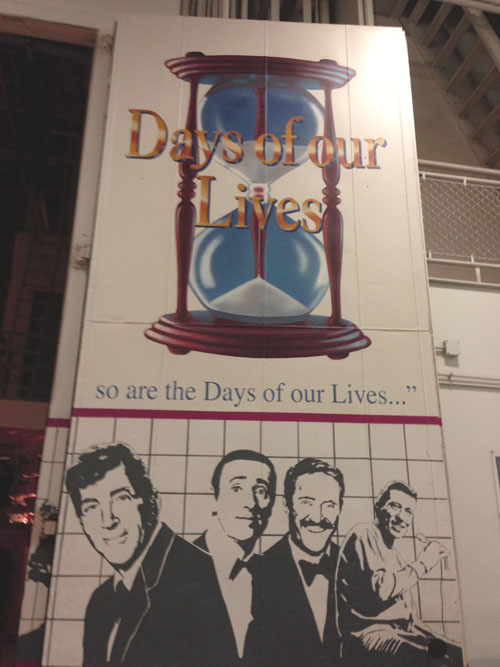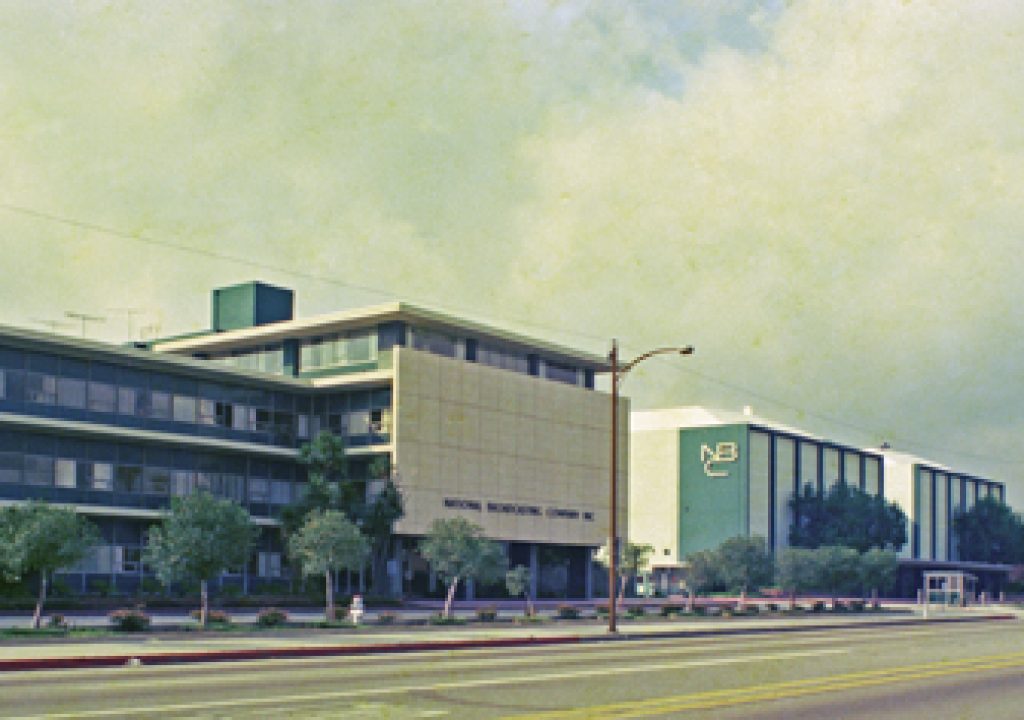In 1982, I began what was to become one of the most favorite periods of my life. I was hired at NBC in Burbank, California. It wasn’t the most prestigious position nor was it the best job I would ever have. But it was the best place I would ever work.
I don’t know what the seed was that began my quest for my Burbank version of a Holy Grail. Was it the legendary stars who walked the hallways from studio to studio? Was it NBC’s parent company, RCA that built nearly all broadcast equipment during that era? Or could it have been the immortal words of Gary Owens as he began every “Laugh-in” show with the famous phrase, “From beautiful downtown Burbank”?
It was probably a little of all of these. The programs emanating from those studios had become a sound track of my life. Suffice it to say, I could at last identify myself with the first facility known during the early color years as “Color City” (CBS had beaten NBC to the title “Television City” with their own temple to the infant industry). Whatever it was that had drawn me, my objective to be a part of this storied location for years had come to pass.
However, this home to programs such as “The Tonight Show Starring Johnny Carson,” “Laugh-In,” “Bob Hope,” “Dean Martin,” “Hollywood Squares,” “Midnight Special,” and so many, many others, will be no more. Several years ago the peacock began the process of closing its feathers for the last time.

One side of the two elephant doors leading into Studio 4. They’re called elephant doors because they are, literally, large enough for an elephant to walk through, but usually they accomodate large sets and vehicles. Decades ago, NBC painted each studio’s elephant door to honor iconic programs that were produced on that particular stage. Photo by author.
The sale of the historic location was completed to the Worthe Real Estate Property Group in 2008. At the time, the sale didn’t have much impact as NBC continued to lease back the property while preparations went forward to move operations to nearby Universal Studios. But slowly, over the last five years, things have changed.
Offices emptied out as executives moved over to the Universal lot. The NBC/Universal owned cable networks moved. On July 6th, 2012, the curtain came down on the famous NBC Studio Tour. There simply was nothing more to show a curious public other than nostalgic references of shows no longer in production.
Today, the only NBC occupants left are “The Tonight Show with Jay Leno,” “Days of Our Lives,” “Access Hollywood,” KNBC, the local NBC station and the NBC News Los Angeles bureau.
Within a few months, they, too, will be gone. When the Winter Olympics begin in February, “The Tonight Show” will cease production and move back to New York 42 years after Johnny Carson first brought the show to California. Ironically, the new incarnation with Jimmy Fallon will move back into the same studio at 30 Rock it left behind.
At the same time, KNBC, the NBC owned and operated station for Los Angeles will move to new facilities on the Universal Studio lot. The station was first licensed to Los Angeles in 1949. When NBC moved the station to Burbank in 1962, the FCC license was changed to Burbank. Now it returns to its Los Angeles roots.
NBC News is scheduled to move to the Universal lot in May. “Access Hollywood” will be the last to leave when the show moves probably in 2015.
The most visible transformation came just before spring of this year – the NBC Peacock signage was replaced with the new company’s logos for the historic lot – The Burbank Studios.
Then and now from the iconic address 3000 West Alameda Avenue, Burbank, CA. Left photo from Google streetview. RIght photo by author
Prior to moving to Burbank, all NBC west coast television operations were housed at Radio City, Hollywood at the corner of Sunset and Vine. The Hollywood facility was built in 1938 primarily for radio. Even in the heyday of radio, television was clearly on the horizon and the design and construction of the Hollywood studios attempted to take that into consideration. However, as the popularity of television exploded after World War II, it became painfully obvious to all the networks their converted radio studios were woefully under built for shows requiring grand sets, sweeping camera movements and large audiences.
NBC Hollywood at the corner of Sunset & Vine. Built in 1938 primarily for entertainment radio, the studios quickly became too small with the advent of television. Los Angeles Department of Water & Power website.
NBC Burbank was formally dedicated on March 27th, 1955. Governor Goodwin Knight designated the occasion Color Television week in California. According to the LA Times the next day, “For the first time from the West Coast, NBC went on the air with a 90-minute color spectacular which most the nation’s viewers saw in black and white.” Very few homes had color sets. NBC was spending a lot of money betting that by providing color programming, color sets would sell.
But NBC Burbank’s history doesn’t begin here. Operations actually began several years earlier.
In September, 1951, a mere ten years after commercial television in America began, NBC purchased nineteen acres from the city of Burbank and thirty acres from Warner Brothers Studios for construction of a new west coast headquarters. The project went forward in phases. When construction began, two studios facing Alameda Avenue along with supporting technical facilities went up quickly.
Almost exactly one year later the first phase was ready. The first two studios would become known as Studio 1 and 3 and both contained permanent audience seating areas for as many as 500 (Later, Studio 3’s seating area is said to have been removed so Andy Williams could shoot his show in the round). The first show from the new facility was NBC’s All Star Revue variety show on October 4th, 1952.
NBC Burbank as it was in 1952 around the time of the first telecast. Studio 1 is on the right and was home to the “Tonight Show” during the reign of Johnny Carson. Bob Hope also preferred the studio for his shows as well. The studio to the left would eventually become Studio 3. City of Burbank via Wes Clark’s Burbankia website
In an interesting side note, CBS was in the final stages of completing its Television City when NBC announced they would go on the air from Burbank on October 4th. Television City’s opening wasn’t planned until November. Not wanting NBC to beat them by going on the air from Burbank first, CBS rushed an episode of “My Friend Irma” into production and televised their first program from an unfinished Television City on the evening of October 3rd, one day before the first telecast from NBC.
The Burbank operation was known for many years as Color City (CBS also having beaten NBC to the name Television City). However, final approval of compatible NTSC color by the FCC did not take place until December 1953, over a year after black & white programs began originating from Burbank. The construction site signage reflects this. During the initial construction phase, it announced “NBC TV Headquarters.” When construction of Studio 2 commenced in mid-April of 1954, the signage changed to “NBC Builds First Color TV Studios.”
The construction signs changed as soon as construction on Studio 2 “Color City” began. Left photo from USC digital archives, right photo courtesy of Kris Trexler (www.kingoftheroad.net)
Studio 2 was the third stage to be built at Burbank and NBC promoted it as the “first studio to be built exclusively for colorcasting.” A new technical operations building was also part of this phase of the construction. The Color City label came to refer to the whole operation even though the network continued to originate black and white programs from the first two studios for several years.
Seven months after the approval of RCA’s compatible color television (also know as NTSC), Studio 2 and the new technical support building were well underway. City of Burbank via Wes Clark’s Burbankia website
When the formal dedication finally came in 1955, NBC Burbank had been producing programs (albeit in black & white) for over two years. As the 90 minute color spectacular entitled “Entertainment, 1955” unfolded in Studio 2, it was clear NBC’s corporate parent had waited to dedicate the facility until it could use it to promote color television.
A little more than seven months later, NBC announced they would build another studio in Burbank. Studio 4 would be an “exact duplicate” of Studio 2 and would be completed in time for the 1956 television season. It was part of a $6,000,000 network expansion program that also included the addition of the 60,000 square foot, three story administration building, construction of additional technical facilities to house the additional color equipment, installation of color recording equipment, more color film facilities (including the Lenticular film process – more to come on that later) and a new master control.
There is wide rumor the construction also included a swimming pool for specials planned with Esther Williams. But the actress was not even working for NBC when either Studio 2 or 4 were built. The earliest arrangement to be found is from the Los Angeles Times in April of 1956 when the network formed a partnership with the swimming star to produce an “Aqua Spectacle.” However, the 90 minute spectacular was done out of NBC’s Brooklyn, NY studio only a few months later. Later, in April of 1957, Ms. Williams was signed to appear in a Lux Video Theater from the NBC Burbank lot. “The Armed Venus” was produced the following month and included one short pool scene at the end of the program. According to the LA Times, a pool was constructed on the stage for the production.
Since there is no mention of any kind of permanent pool or tank in any promotional material or in any of the industry trades, it can be presumed that the story is urban legend and took on a life of its own. However, according to a Broadcasting Magazine article from March 21st, 1955, Studio 2 had an audience pit at one time, although that information appears nowhere else. Examination of a picture of Studio 2 under construction gives no evidence of any kind of pit or tank.
Interior of Studio 2 under construction just six months from it’s first live color “spectacular.” City of Burbank via Wes Clark’s Burbankia website
In November, 1962, the Owned and Operated NBC station, KNBH (later KRCA then KNBC) moved to Burbank from the Sunset and Vine location. Within a couple of years, the Sunset and Vine location was demolished as entertainment oriented network radio quickly faded into oblivion.
Demolition of NBC Hollywood in 1964, the site of many classic radio shows as well as early television productions. A bank occupies this portion of the site today. From radiocityhollywood website
Over the succeeding years, NBC’s Burbank presence amassed a rich history of producing outstanding comedy, variety and musical programs. Aside from the notable shows and memories produced on the Burbank stages, technical advancements were made there as well. The most obvious is in the name it adopted – Color City.
As mentioned before, color television was brand new. In order for NBC’s parent company, RCA, to sell color receivers, there had to be color programming. Color cost more but the equipment wasn’t very accurate yet. Sets and wardrobe had to be specially made to appeal to the imagery of early equipment that wasn’t always reliable or consistent. All of this translated into extra costs advertisers were hesitant to ante up.


